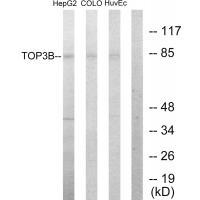Releases the supercoiling and torsional tension of DNA introduced during the DNA replication and transcription by transiently cleaving and rejoining one strand of the DNA duplex. Introduces a single-strand break via transesterification at a target site in duplex DNA. The scissile phosphodiester is attacked by the catalytic tyrosine of the enzyme, resulting in the formation of a DNA-(5'-phosphotyrosyl)-enzyme intermediate and the expulsion of a 3'-OH DNA strand. The free DNA strand than undergoes passage around the unbroken strand thus removing DNA supercoils. Finally, in the religation step, the DNA 3'-OH attacks the covalent intermediate to expel the active-site tyrosine and restore the DNA phosphodiester backbone By similarity. Possesses negatively supercoiled DNA relaxing activity.
Ng S.-W., Nucleic Acids Res. 27:993-1000(1999).
Kawasaki K., Genome Res. 7:250-261(1997).
Collins J.E., Genome Biol. 5:RESEARCH84.1-RESEARCH84.11(2004).

